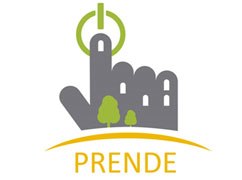
PRENDE
The PRENDE Project (“Platform for the Energy Refurbishment of Eco-efficient Urban Districts”) is part of the INNPACTO Programme announced by the Ministry of the Economy and Competitiveness of the government of Spain as part of the constitution and internationalisation of the R&D System in the thematic sector of “Energy”.
To develop the project, the Centre for the Innovation of Smart Infrastructures is part of a consortium led by Ferrovial Agroman and made up of the Centre for the Innovation of Smart Infrastructures (CI3) and Ferrovial Conservación S.A. (FERCONSA), a company in the Ferrovial group, Empresa Municipal de Vivienda y Suelo of Madrid City Hall (EMVS, Municipal Enterprise for Housing and Land), communication company 3Lemon and Centro de Investigaciones Energéticas, Medioambientales y Tecnológicas (CIEMAT, Centre for Research on Energy, the Environment and Technology), a public research organisation.
The PRENDE Project consists of creating a service that focuses on citizens, offered through IT tools (Information Technologies) that are easy to access and use. The system provides information and channels local interest to improve the energy efficiency of each district through the energy refurbishment of properties and the recommendation of good practices.
The Project is implemented in several districts of Madrid to study and put in place measures that encourage energy refurbishment through the design and development of the IT tool-based PRENDE service.
One of the fundamental challenges facing PRENDE is to integrate citizens in the refurbishment process, make them aware of the need for doing so and of the immediate and long-term benefits of improving the energy efficiency of their homes, area and city.
To date, traditional campaign techniques have been used and results have been very limited. The PRENDE project will look at the problem, developing and applying integrating methodology based on innovation in a variety of areas (engineering, project management, the theory of communication and behaviour, etc.) to implement a new strategy for encouragement and communication focused 100% on citizens.
This method will generate a strategy and communication plan based on non-conventional resources and actions through specifically designed indicators to control progress within the strategy and correct the actions as necessary. The application of this type of action in the field of energy efficiency and refurbishment and the measurement and characterisation of the results returned by the various actions is new in this type of campaign and innovative for the refurbishment sector.
The PRENDE service is based on IT tools through the development of an Internet platform with an innovative appearance that focuses on the system software architecture. The aim is for the architecture to have real-time access to any original data (infography, types) or (previously) calculated data in accordance with user requests, with an acceptable response time, new calculations that take the environment into account and parameters that result from previous simulations. The software architecture design will be based on agents, modules that incorporate knowledge automatically and that are used as the main element of innovation for said purpose.
The actions and contents offered in the PRENDE service will reflect the benefits arising from the integration of renewable energies, the reduction of architectural barriers, the improvement of accessibility and the savings achieved by applying the principles of energy efficiency. The new aspect of the generation and publication of these contents focuses on the end user. Their adaptation to the citizen’s characteristics: needs, level of involvement, knowledge of energy, etc., effective bi-directionality in the communication and channelling of the participants’ voices enables dissemination and the adaptation of the communication of the project messages to a language that is accessible for end users.
The long-term success of the PRENDE Project will be confirmed with the energy refurbishment work carried out on the ten million first residences built in Spain before 2001, which need to be turned into low-consumption homes with low-level greenhouse gas emissions. The work would provide benefits not only for owners and occupants, but also for the country’s economy as a whole, creating between 110,000 and 130,000 stable direct jobs between 2013 and 2050 through the annual investment of €10,000 million in energy refurbishment to improve between 250,000 and 450,000 homes each year. The investment will be made by family savings, banks, energy service companies, energy distribution companies and the State. Each source of investment will receive different returns from energy savings and emissions, social benefits and improvements to housing quality.1
Finally, the PRENDE Project seeks to revitalise the national housing refurbishment sector, which is technologically highly advanced and offers much potential, by encouraging citizen participation so that Spanish businesses in the sector can improve their competitiveness on both a national and international scale. This will help them increase their refurbishment portfolio in countries emerging as new economic powers, helping to overcome the current situation.
More information: www.proyectoprende.com
